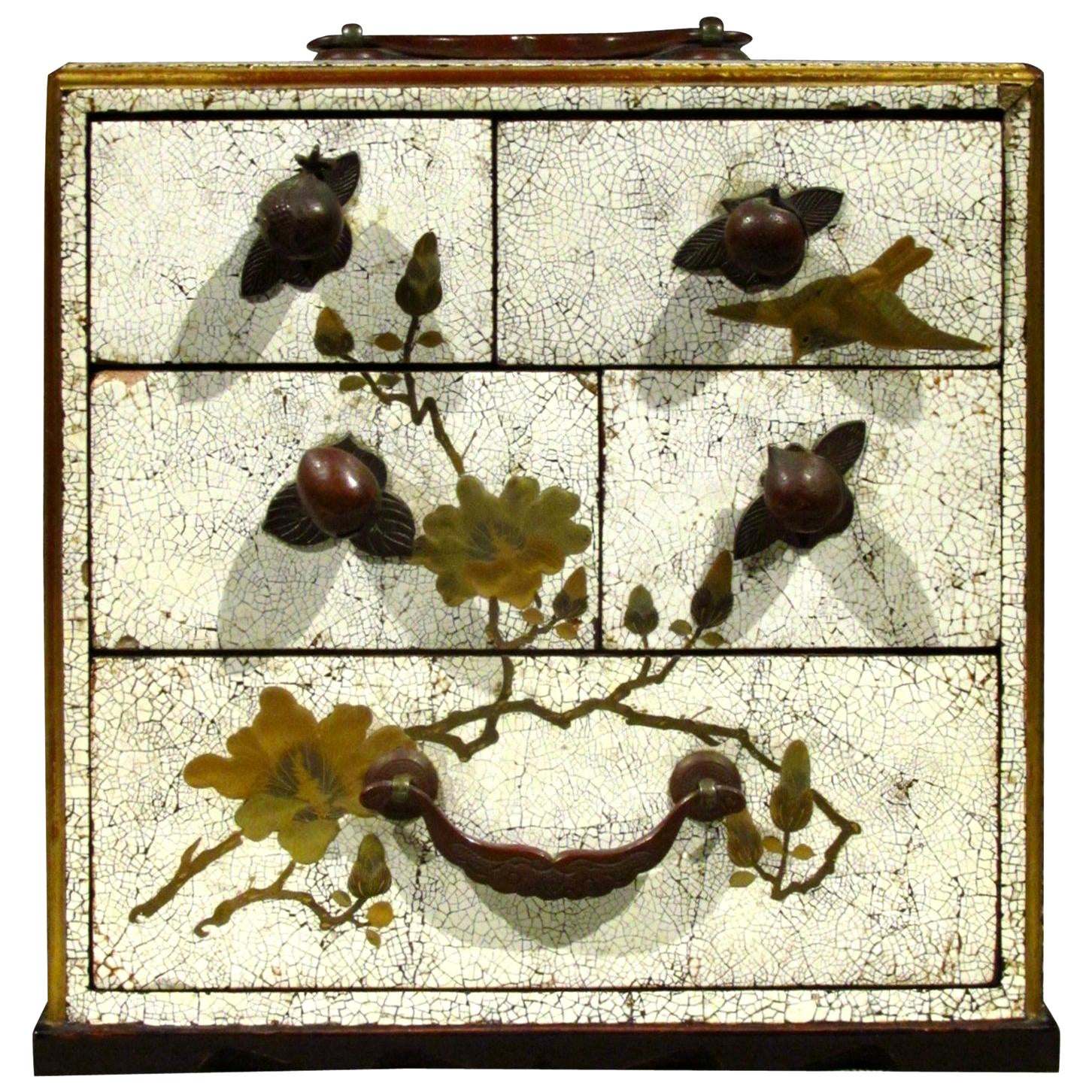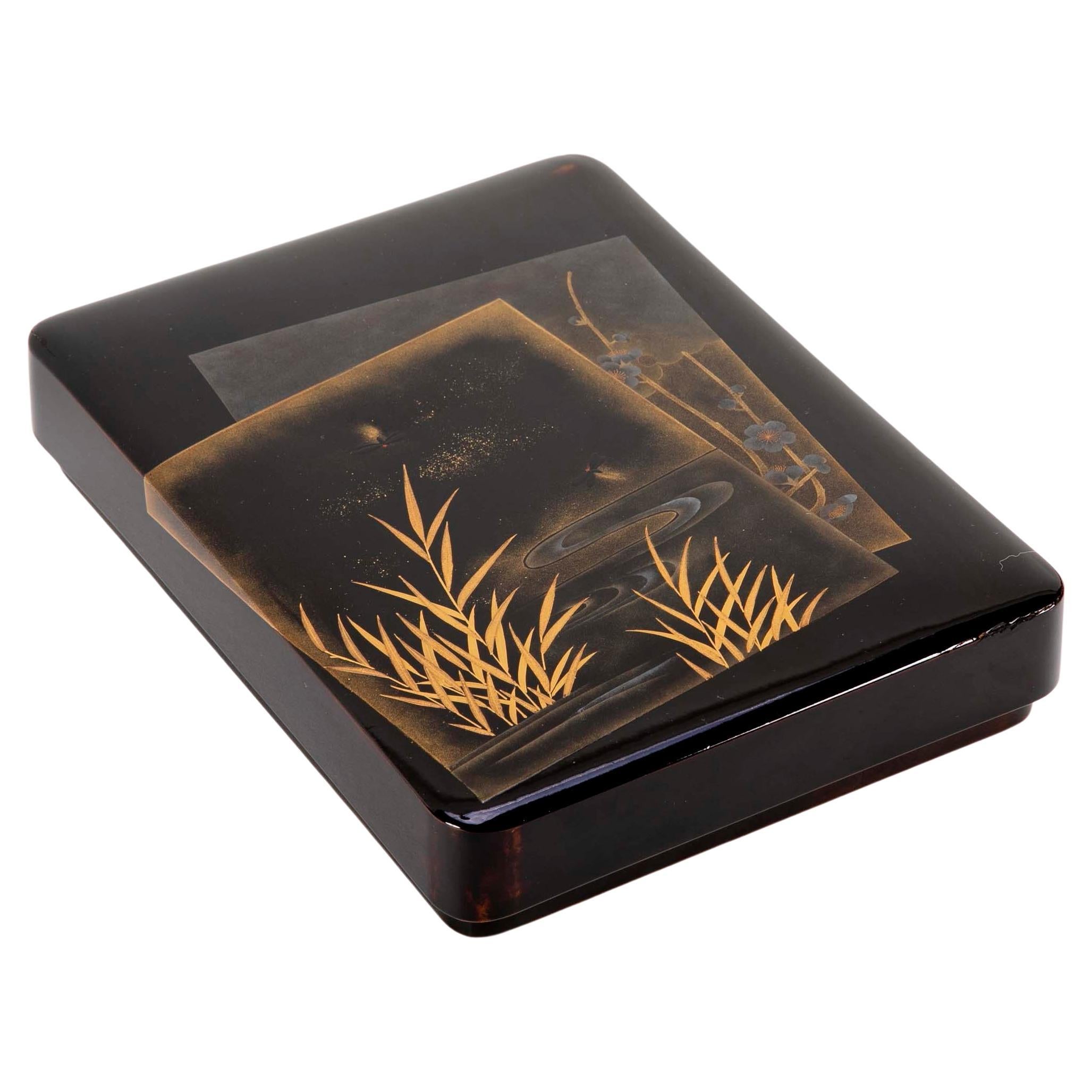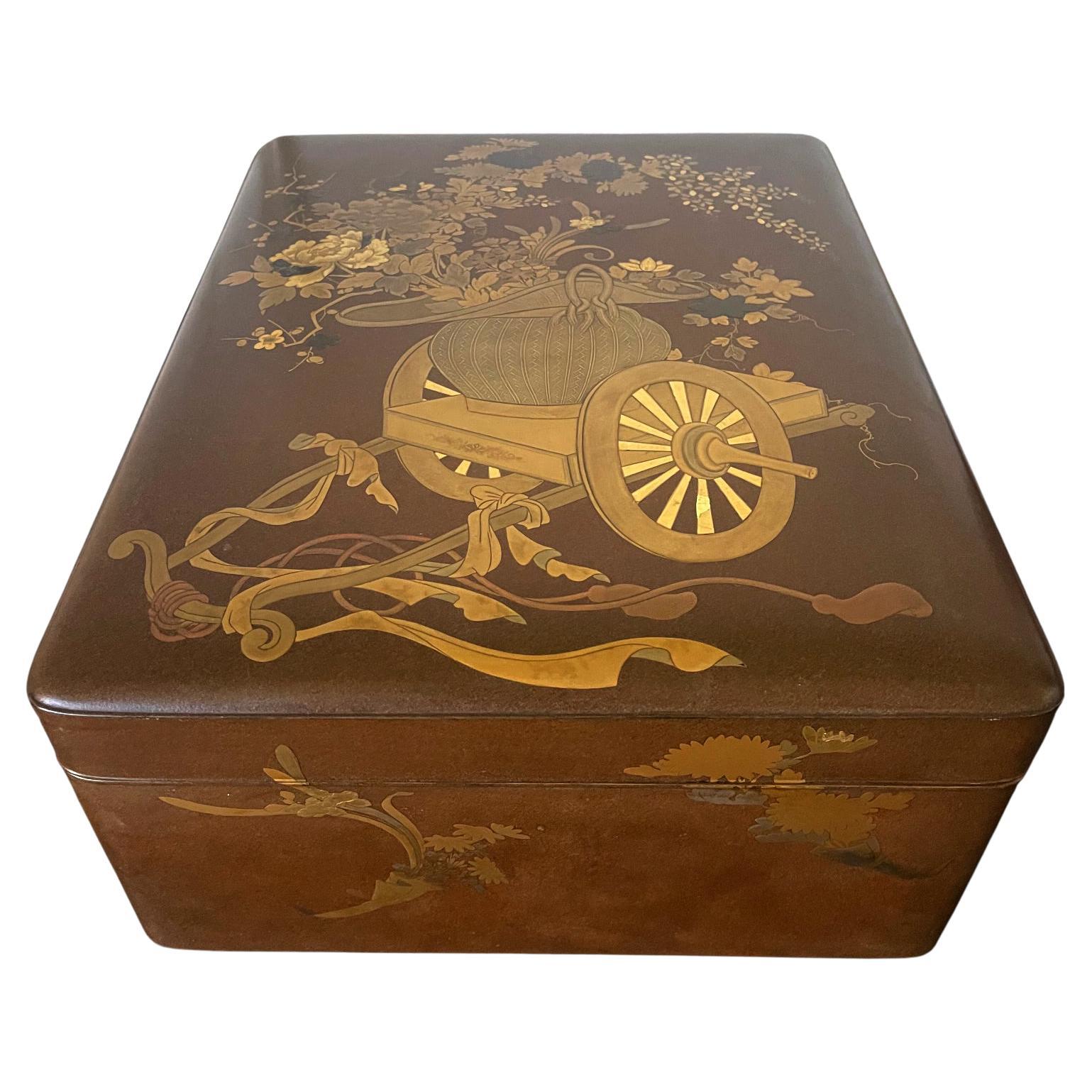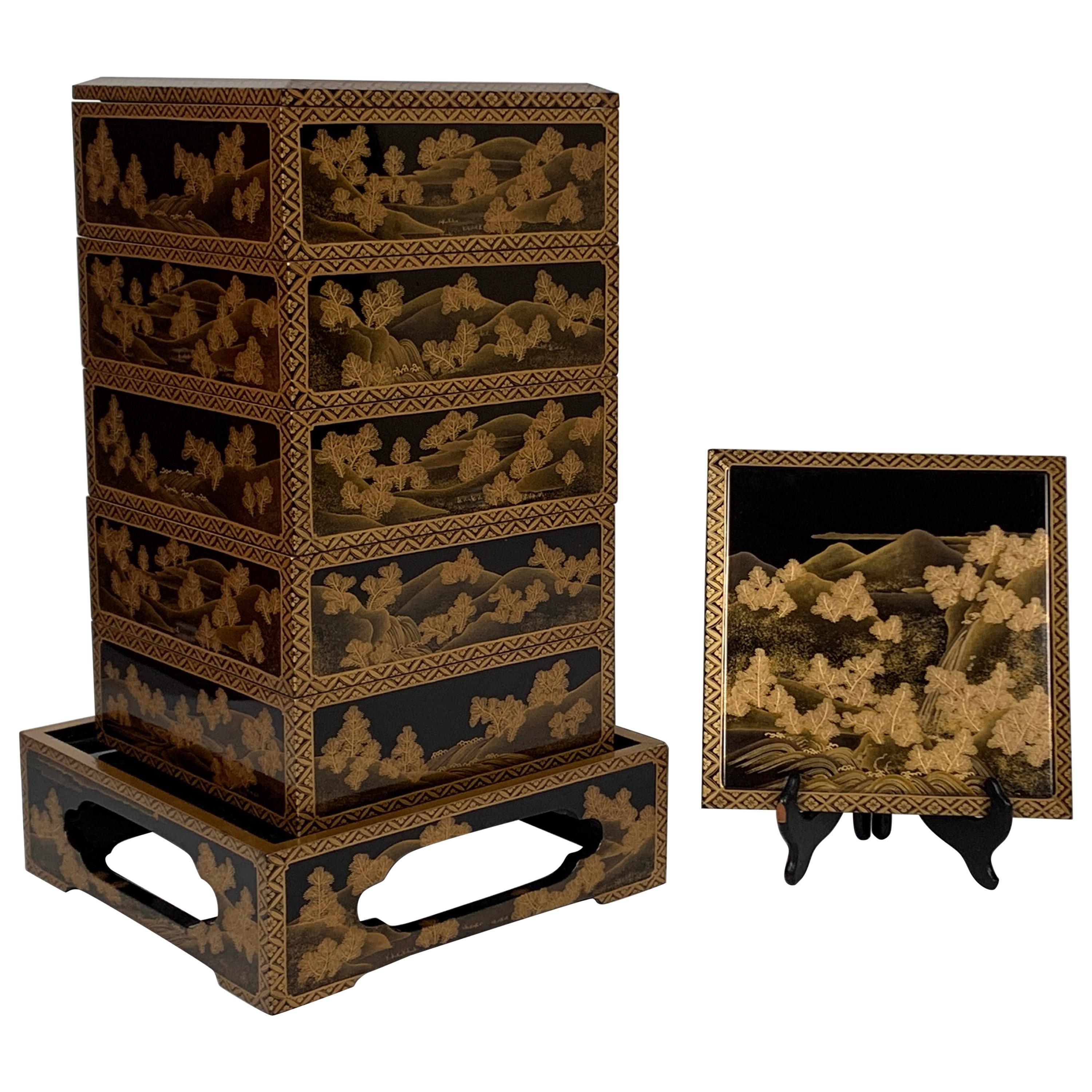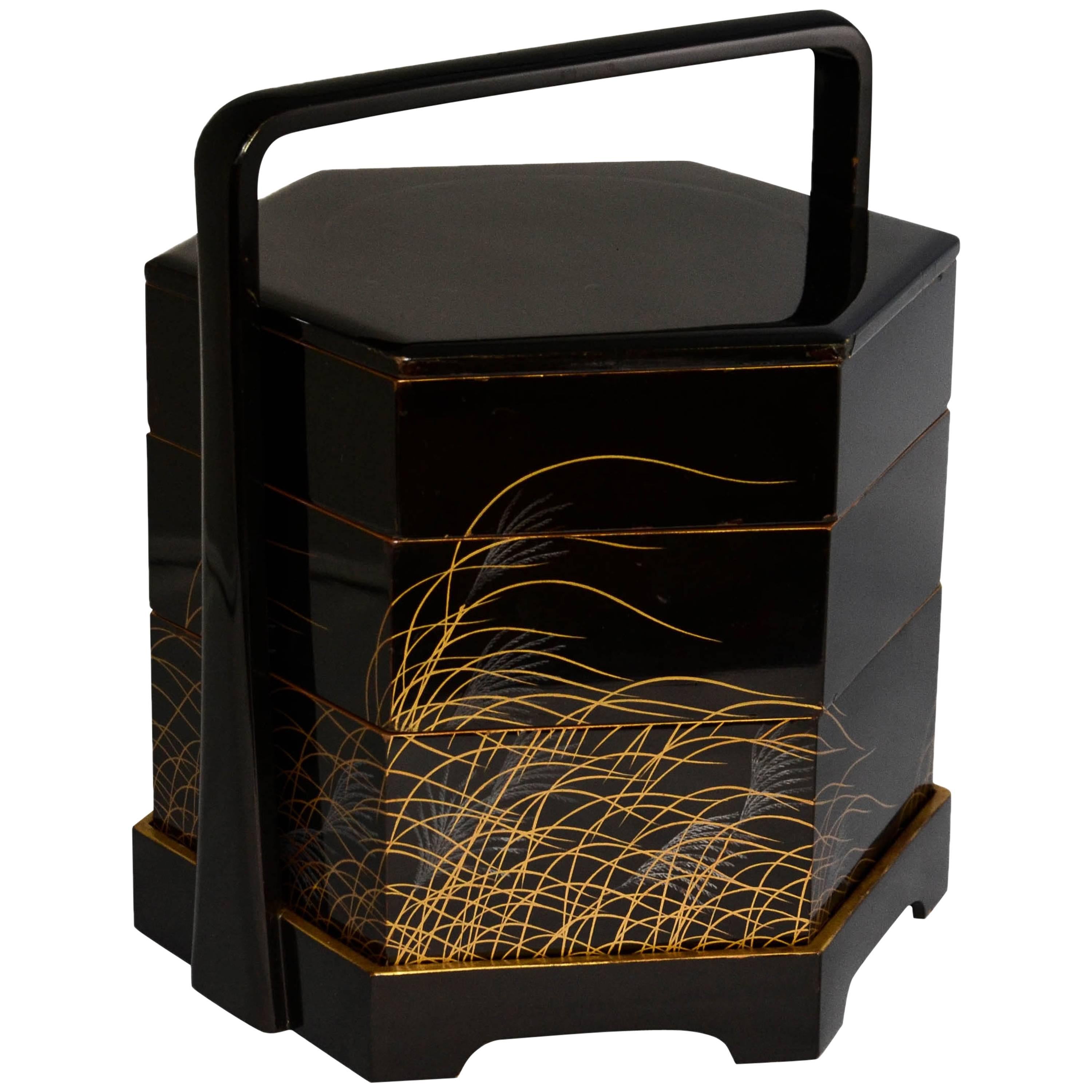Items Similar to Japanese Lacquer Maki-E Tiered Suzuribako and Ryoshibako
Want more images or videos?
Request additional images or videos from the seller
1 of 19
Japanese Lacquer Maki-E Tiered Suzuribako and Ryoshibako
About the Item
A Japanese roiro lacquer scholar combo box with an upper tier of inkstone box (Suzuribako) and a lower document box (Ryoshibako) circa 1910-30s (end of Meiji to Showa period). The high glossy box was beautifully decorated with an image of the famously eccentric Buddhist monks Hanshan and Shide (known in Japan as Kanzan and Jittoku). Often as a pair, they have been a popular motif in Japanese Zen painting, representing deeper philosophical meanings and mysterious symbolism.
Hanshan or Kanzan ("Cold Mountain") and Shide or Jittoku ("found") were legendary Zen monks living in the Tang Dynasty (618–907) of China. The two close friends were often depicted as unconventional mystics, disheveled in appearance and mischievous in manners. Kanzan is identified by the pen and scroll he holds while Jittoku by a broom as he worked a kitchen cleaner. It was said that they communicated with a gibberish language only understood by them and were deemed lunatic and carefree. In Japan, starting in the Muromachi period (1336-1573), they were regarded by many scholars as the incarnations of Manjusri (Monju) and Samantabadhra (Fugen) and became a very popular motif in Zen Buddhism art.
The rendition of the two monks on the box cover is very similar to ink painting except that it was done in hiramaki-e technique. Confident, bold strokes and contrasting colors of gold and silver were used to create a slightly abstract illustration with depth and dimension. The faint forest in the background was executed in the Togidashi, the demanding technique achieved a desired misty and dreamy effect. The composition works very well with the contrasting techniques and together, they achieve a painterly quality on a different art medium.
The Suzuribako contains a suzuri (ink-stone) with fundame trim and a round cloisonne suiteki (water dropper) with wave design. While the exterior of the box is largely glossy black, the interior was rendered in contrast with texture of vertical ripple lines.
- Dimensions:Height: 4.125 in (10.48 cm)Width: 9.5 in (24.13 cm)Depth: 10.5 in (26.67 cm)
- Style:Meiji (Of the Period)
- Materials and Techniques:
- Place of Origin:
- Period:
- Date of Manufacture:1910-1930s
- Condition:Wear consistent with age and use. Good condition with minor shelf wear and a couple of surface scratches on the base. One corner of the lower box has a thin crackle line with possible touchup, not readily noticeable.
- Seller Location:Atlanta, GA
- Reference Number:1stDibs: LU945031292012
About the Seller
5.0
Platinum Seller
These expertly vetted sellers are 1stDibs' most experienced sellers and are rated highest by our customers.
Established in 2006
1stDibs seller since 2010
479 sales on 1stDibs
Typical response time: <1 hour
- ShippingRetrieving quote...Ships From: Atlanta, GA
- Return PolicyA return for this item may be initiated within 2 days of delivery.
More From This SellerView All
- Japanese Lacquer Ryoshibako Document Box Meiji PeriodLocated in Atlanta, GAA large Japanese lacquer box with elaborate Maki-e design from Meiji period, (mid-late 19th century). The generous size of the box was reser...Category
Antique 19th Century Japanese Japonisme Lacquer
MaterialsWood, Lacquer
- Japanese Maki-e Lacquer Stack Box JubakoLocated in Atlanta, GAAn antique jubako (stack boxes) with five tiers in an elongated octagon shape circa 19th century (end of Edo or beginning of Meiji period). jubako was traditionally used to store and...Category
Antique 19th Century Japanese Japonisme Lacquer
MaterialsWood, Lacquer
- Rare Japanese Lacquer Writing Box Suzuribako Meiji PeriodLocated in Atlanta, GAA Japanese Lacquer writing box Suzuribako Meiji Period (1868-1912), likely circa late 19th century. This suzuribako is one of the most unusual boxe...Category
Antique 19th Century Japanese Japonisme Lacquer
MaterialsLacquer
- Japanese Rinpa Style Lacquer Ink Stone Box SuzuribakoLocated in Atlanta, GAA Japanese writing box with ink stone (known as Suzuribako) with exquisite maki-e decoration circa late Meiji to early Taisho period (1890s-1930s)...Category
Early 20th Century Japanese Japonisme Lacquer
MaterialsWood, Lacquer
- Japanese Lacquer Maki-e Sake Ewer Meiji PeriodLocated in Atlanta, GAA Japanese lacquered wood sake ewer with maki-e design, circa late 19th century, Meiji period. The nicely decorated lacquerware is of a Classic sake ewer for...Category
Antique 1890s Japanese Japonisme Lacquer
MaterialsLacquer
- Japanese Lacquer Box with Fine Maki-e Decoration Meiji PeriodLocated in Atlanta, GAA lacquered wood box with lid from Japan circa 19th century Meiji Period. The finely decorated box was used to store paper slips and small documents on the desk. It is overall finished with black lacquer (kuro) with sparse Mura-Nashiji effect outside and on the top surface of the lid, there are three Komainu, (sometimes known as Shishi or Japanese lions) frolicking and forming a circle in lively motion. Komainu are auspicious animals in Japanese cultures in both Shinto and Buddhism tradition. Originally from China, these animals symbolizes guardians to ward off evil spirits. Hiramaki-e was used in combination with carving and combing to render the lions with various surface textures. A gilt border with an slight angle was given to the lid and even the thin band is decorated with miniature floral scrolls. The interior of the box was finished in a dense nashiji. Underneath the lid, a cluster of peonies open lavishly by two gentle mounts. Takamaki-e (high relief) in both gold and silver were...Category
Antique Late 19th Century Japanese Japonisme Lacquer
MaterialsWood, Lacquer
You May Also Like
- Signed Japanese White Lacquer and Maki-E Lacquer Tansu, Meiji PeriodLocated in Ottawa, OntarioThe case decorated overall in crackle-glaze white lacquer and fitted with a patinated metal carrying handle over three tiers of small drawers. The first two tiers are comprised of a ...Category
Antique Late 19th Century Japanese Meiji Lacquer
MaterialsLacquer
- Black and Gold Lacquer Japanese Suzuribako BoxLocated in Stamford, CT19th century Japanese black and gold lacquer Suzuribako box with firefly and plum blossom design.Category
Antique Late 19th Century Japanese Decorative Boxes
MaterialsLacquer
- Japanese Maki-e Lacquer Stacking Box, Jubako, Meiji Period, JapanLocated in Austin, TXA fine and impressive Japanese gold maki-e decorated black lacquer five-tier jubako with presentation tray, two lids, and the original tomobako storage box, Meiji period, late 19th c...Category
Antique Late 19th Century Japanese Meiji Lacquer
MaterialsLacquer
- Antique Japanese Lacquer O-Bento Box with Gold and Silver Maki-E DecorationLocated in Prahran, VictoriaAn unusual hexagonally shaped antique Japanese three-tiered o-bento box with a carrying tray decorated with a classical Rimpa style gold and silver Maki-e lacquer design of gently sw...Category
Antique Early 1900s Japanese Meiji Lacquer
MaterialsLacquer, Wood
- Japanese Meiji Period Antique Lacquer Box with Gold Maki-e DecorationLocated in New York, NYA fine antique Japanese Meji Period lacquer box decorated with a fan and a stylized star shaped window in the maki-e technique. The fan at the top right corner, fully opened depictin...Category
Antique 19th Century Japanese Meiji Lacquer
MaterialsLacquer
- Japanese Tiny Suzuribako 'Writing Set'Located in PARIS, FRTiny suzuribako (writing set) in black and gold hiramaki-e lacquer with water plantain (Alisma plantago-acquatica) decoration. Interior in nashi-ji lacquer, with a rectangular water cup...Category
Antique Late 19th Century Japanese Lacquer
MaterialsLacquer
